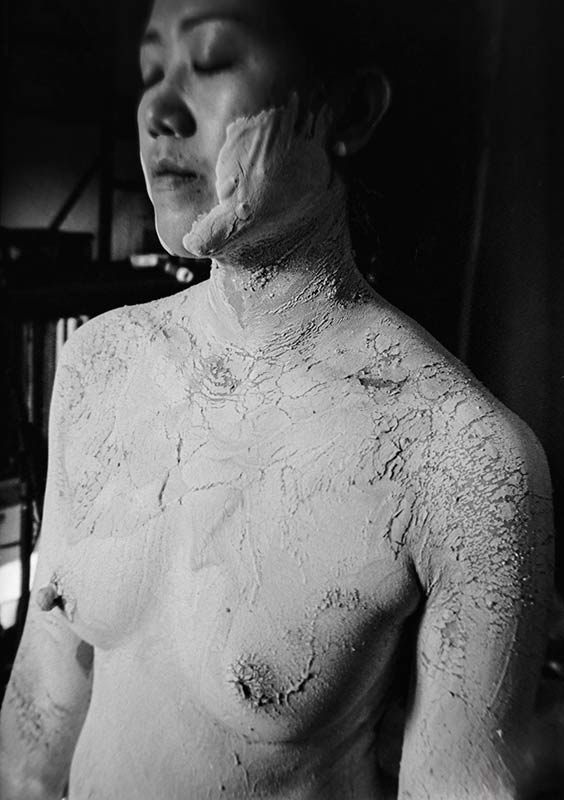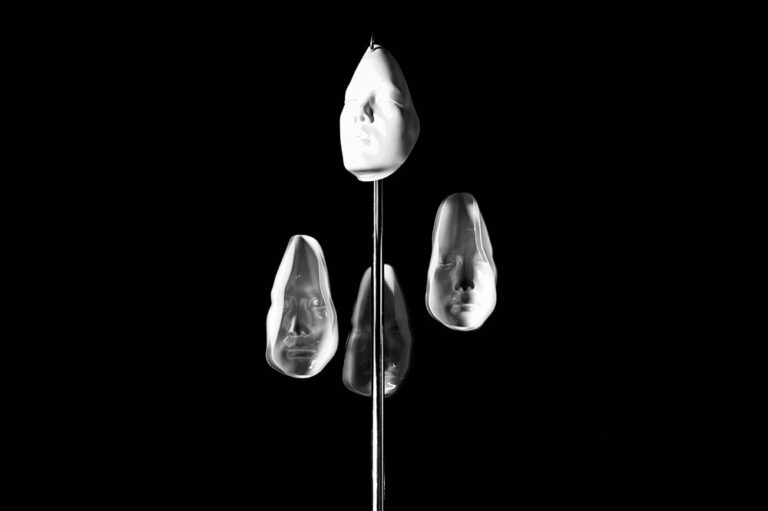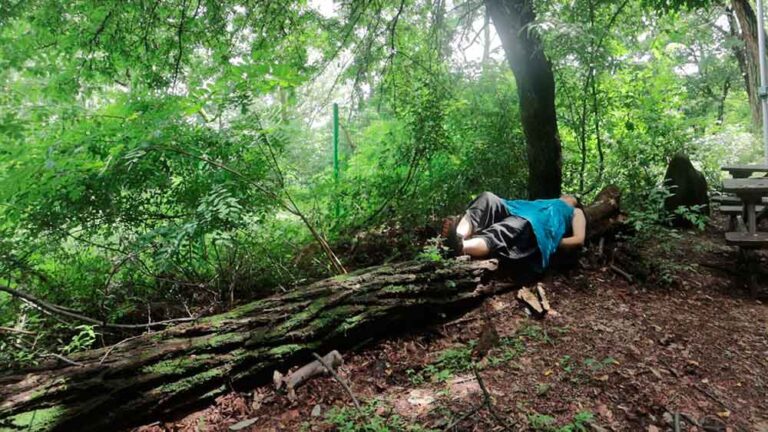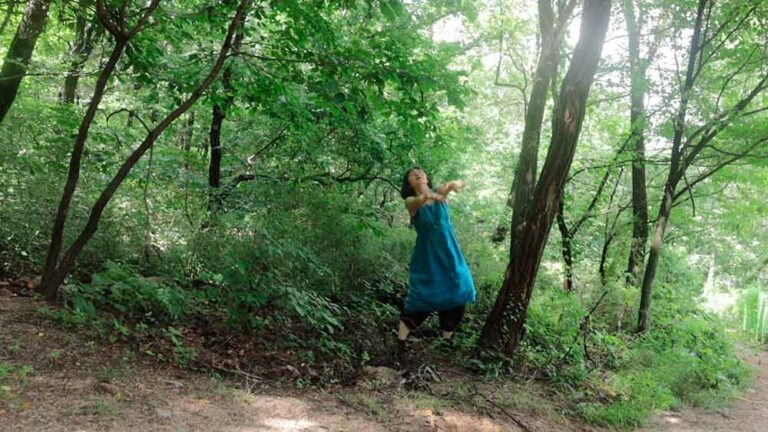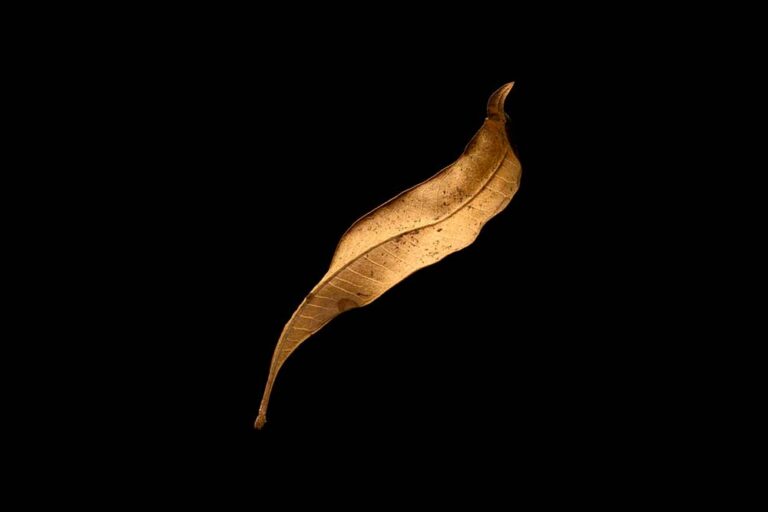Notes on a project by Rainer Junghanns
written by Jürgen Raap
Rainer Junghanns initiated the project „Raum für Raum“ in Düsseldorf, which has taken on a global dimension with the trilogy „global art project“ – as the name already announces. After the first two parts „HIDDEN_ messages“ and „nomansland.academy“, the third and final part is „undress me my little B U D D H A“.
The first exhibition station will be the IPO Alternative Artspace in Seoul (South Korea) from 3 to 19 November 2023. A second exhibition is in Mexico D.F. in February 2023 in collaboration with Hashi Gallery and Sphere Salon. This third part of the trilogy is set across a wide range of media: Byunkaka and Ying Yun Chen, for example, place artistic emphasis on dance and performance, others work with photography such as Lena Nowhere, video sculpture/object art or installation. Of course, not all conceptual approaches can be described in detail or even mentioned here.
HIDDEN Messages“ was about artistic statements by contemporary witnesses about their real experience of social isolation during the Corona pandemic of 2020/21. nomansland.academy“ dealt with „identity“ in various socio-cultural contexts, including the processes of transformation from the real-analogue to the digital or the changes we are now experiencing as a result of the climate crisis. What significance then do rituals still have under today’s social, technological and cultural conditions? What does „belonging“ or „home“ mean in the current globalised world, where on the one hand the traditional social rules of a tribal society still apply in many regions, but on the other hand the individual is often exposed to a situation of uprooting and alienation? Lynn Hyeong, for example, deals with this in her series „Chaosmose; in which she examines the interplay „between personal disturbances and the challenges of climate change“.
In this part of the project „undress me my little B U D D H A“ (whereby this poetic title refers to two media images by Arthur Jafa and Rainer Junghanns), the aim is to reflect on an idea of the „true self“ under the premise that this „self“ is ideally able to express itself in different strategies of artistic self-discovery. Such „self-discovery“ in artistic creation can then expand sociologically into the assumption of a special role.
In the 19th century, for example, the bohemian or the dandy practised a form of life that was considered a counter-design to the existence of the bourgeois, the citizen of capital. The German and other European „painter princes“ of the 19th century and their public’s fixation on the hand-generated individual work celebrated a romantic individualism of the artist that had an anti-industrial character in that it consciously opposed uniform mass production in factories and the formation of mass societies at a time when, for example, the populations of Paris and Berlin increased tenfold between 1800 and 1900, i.e. within a single century. The promise of „Life, Liberty and the pursuit of Happiness“, i.e. as a guarantee of personal happiness, as enshrined in the US Constitution of 1776, proved illusory in everyday life in the former slums of the industrial metropolises.
Some artists reacted to this with an escapism tired of civilisation (female artists were still underrepresented in the art world of the late 19th century). Paul Gauguin, for example, retreated to the Pacific region because he hoped to find personal happiness and thus his „true self“ in an apparently „unspoilt“ natural habitat. Such artistic self-realisation was only possible, however, because the bourgeois revolutions in Europe in the 18th and 19th centuries abolished the guilds and introduced freedom of trade, which – with a parallel enforcement of academic freedoms in the face of feudal despotism – allowed artists to develop their own personal style, both in their external habitus and in their creative work.
Whereas until the end of the 18th century the painters‘ guilds had laid down technical rules that did not permit frank experimentation, and the patrons, nobles and church dignitaries, almost always determined the content of the pictures, the role of the artist changed in the era of bourgeois emancipation in Europe from that of a craftsman bound by the guild to that of a „freelancer“. In the 20th century, this changed understanding of the role culminated once again in the self-representation practices of classical art performance since 1970/80 and in the revival of the aforementioned „painter principality“ in the neo-expressive German painting of the 1980s and 1990s.
In the development of recent art history, however, this did not go unchallenged: As early as around 1960, Andy Warhol countered the anti-bourgeois bohemian attitude with his „factory“ principle, and in his painterly iconography he replaced „identity“ with a medially exaggerated and enraptured „image“. In that era, stars like Marilyn Monroe or Elvis Presley embodied a super-aesthetically staged image that was communicated through the media but had nothing in common with the actual character traits of the private persons Monroe or Presley, i.e. with their „true selves“.
In other artistic strategies, individual authorship is currently being questioned, for example in appropriation art or in the current collectivist models, such as those presented at the Kassel documenta 2022. Here, it is no longer about artistic self-expression out of an inner necessity, but only about art as a means of realising activist projects with which political goals are pursued.
In non-European cultural circles, identity politics as a process of self-discovery often leads to an anti-colonialist strategy of overcoming centuries of cultural paternalism and thus foreign domination, which in some places still has repercussions into the 21st century. This project „undress me my little B U D D H A“ therefore also explores the question of how different ideas of freedom (and experiences of freedom) are discussed under today’s conditions of media communication in the respective social spaces. In her work, Hyekyung Son ties in with a concept of alienation critical of capitalism and thus also with the 19th century romanticisms just described, when she explains that the human being „hardly exists any more as an independent self or ego, but as a mere component of capital; in other words, capitalist society, which represents modern human freedom, conversely stands for the degradation of the human being and his self…“.
In terms of the sociology of art, it has long been accepted that in the 20th century there was not just one European modernism as a leading cultural model, but rather a multitude of modernisms that developed in parallel and independently of each other on all continents at the same time. „In the past, the idea of pop was that people gathered to form collective identities,“ says Jens Balzer about the development of the „zeitgeist“ in Germany and some other Western European countries in the second half of the 20th century. With tattoos, for example, the „will to be different… seemingly irrevocably inscribed in the body“. In the highly commercialised art trade of our day, however, the artistic personality style has been transformed into a mere trademark – at the major international art fairs, it is ultimately only about „branding“ for an oligarchic collector audience, but no longer about an existentialist self-exploration, which in performance art can sometimes lead to a physical borderline experience or even transgression. In a world of sober economic rationality, however, it is at the same time a privilege to deal in art with longings that cannot be further explained, as Melanie Balsam Parasole puts it.
In this third part of the trilogy, the artists use very different strategies to explore the question of who one really is in the age of avatars and artificial intelligence, and how this could be expressed artistically. Setsuko Fukushima, for example, who is represented in all three parts of the project, develops her works from found objects from walks and then transforms these objects and materials into works with a highly personal signature. She physically compiles her drawings from the last two years in a book and thus achieves an intellectual condensation of the material. Choe Rayun also works with materials taken from everyday life or nature. Keisuke Matsuura, on the other hand, lays out his works in space and as wall pieces with formal rigour, using gold leaf in a series of works in a manner reminiscent of Buddhist mysticism. With „Renasce“, Omar Rosales ties in with Buddhist ideas of karma – i.e. the idea of a spirit continuum that passes through many lives, whereby the concrete conduct of life in the now can produce a determinant consequence for a life in the future. Miryeon Kim documents mental changes after a serious illness and thus achieves a reconfiguration of her ego in her paintings.
Not only in Kim’s work, but also in other contributions to this project, mental processes represent inner movements, as they could be described in a novel of development, and in the age of a globalisation of politics, economics and cultural exchange, they are at the same time equally connected with external movements. Maho Maeda focuses her introspection on the formula „me inside me“. In May 2023, Rainer Junghanns showed an installation in Cannes with a wide-stretched line of clothes hangers from which photos hung. In these photos, he himself is usually only seen in a back view, and yet this work is to be understood as a cipher of how privacy is experienced and can be communicated to the outside. An inner, mental movement merges into an outer movement. This can also be described as a kind of pilgrimage: the traditional pilgrimage is always about repentance, purification and spiritual experience. Sunjoo Lee’s photographic works can be described as a lyrical journey into her personal circumstances, and at the same time she explores the world through an interweaving of different time levels. Erik Bachtold M does this in a similar way with a video that consists of four levels with similar images, but which were created at different times and in different places, „but which we perceive at the same moment“.
Thus, in artistic travel projects and exchange projects such as those initiated and carried out by Junghanns, movement in (global) space cannot be explained solely in terms of the logistically significant vectors of acceleration as in high-speed trains or in telecommunications with its split-second data transfers. Paul Virilio described such movement processes in a transhistorical way in his Dromology, and Jean Baudrillard propagated „the end of perspective space and the panopticon“ and even the „end of history“ as a consequence of this global acceleration. But man is precisely not a-historical. One of his most important anthropological conditions is the ability to see spatially. Thus, in a current phase of his work, Harald Hofmann starts from scenographic sketches that are to be understood as extended painting. The spatial models he develops from this sometimes refer to Albrecht Dürer and to the world view of the early modern period, in which a different understanding of space was arrived at than was customary in the Middle Ages. I-shu Chen, meanwhile, addresses spatiality with „fake landscapes“, and June Pak questions the concept of nationality, which is always tied to territorial hegemony. In this respect, some artistic concepts, especially where they are utopian, prove to be counter-strategies to the sober rationalism of purpose that dominates politics.
August 2023
′undress me my l i t t le B U D D H A′
is Part I I I of a ′Global Art Project ′-Trilogy on the theme of ME / SELF
The first exhibition will be shown at
대안예술공간이포 / IPO Alternative Artspace, Seoul
Opening November 3 th to 17th 2023
The second exhibition will be shown at
HASHI Gallery, Mexico City
Opening February 7 th to 18 th 2024
ISHU CHEN
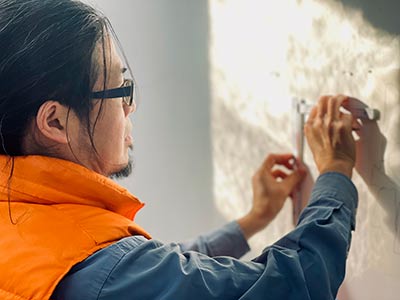
Landscape deconstruction – Year: 2023 – Size: 287,5 x 7,8 cm – Acryl, carbon Paper on Leporello
The work is based on Fake Landscape series, the composition becomes unpredictable due to the working process as I draw on carbon paper. Do I have to scroll from time to time to secure the resulting tracks? Eventually, a new series develops that I call „Landscape Deconstruction“!
1970 Born in Taipei, Taiwan
1989-1993 Faculty of Fine Arts, Tung Hai University Taichung
1998-2000 Academy of Fine Arts with Prof. M. Prachenski
2000-2004 Düsseldorf Art Academy with Prof. David Rabinowitch Master Student of Prof. David Rabinowitch Letter from the Academy
KEISUKE MATSUURA

1970 born in Kyoto, Japan – Lives and works in Düsseldorf, Germany
1990-94 TAMA Art University, Tokyo, bachelor of Fine art in Oil Painting
1994-96 Master’ course at the TAMA Art University, Tokyo, Master of Fine Arts
1997-2004 Kunstakademie Düsseldorf, Germany
Prof. Christian Megert, Department of the Integration of Visual Art and Architecture,
completed master student and. Prof. Daniel Buren, attained Diploma
SUNJOO LEE

Sunjoo Lee is a mixed media photographer based in Seoul, South Korea.
Lee’s extraordinary artistic sensibility that once portrayed through her voice is now visible from the work she portrays through her camera lens. Her photography focuses on a unique lyrical journey into her personal life. She explores her past, present, and future world in a time and spatial perspective.
MA, Department of Plastic Art & Photography, Chung-Ang University Graduate School, Seoul, Korea.
Bachelor of Fine Arts (Academic Credit Bank System)
Photography, Chung-Ang University, Seoul, Korea.
Bachelor of Arts and Music
Ewha Woman’s University, Seoul, Korea
MELANIE BALSAM PARASOLE

HEY – Looking for connection
I have a longing inside me that I can’t explain. For something I cannot describe.
I read about a Gnostic myth: There is a divine world of light and the dark chaos world of demons. At some point a being of light fell from heaven into the chaos world. In the process, it was shredded into countless sparks by demons and these sparks landed in the hearts of people. Since then, people have carried an inexplicable longing for a place that cannot be reached.
Others have been trying to find an explanation for their longing long before me. The path seems to be blocked, but that doesn’t mean you can’t still look for it.
*1974 in Böblingen, Germany
lives and work in Essen
RAUM _ fuer _ RAUM Particpant:
Cubes & Boxes, 2019, HIDDEN _ Messages 2020, nomansland.academy 2021,
undress me my little B U D D H A 2023
Solo Exhibition in RAUM _ fuer _RAUM:
Postcards from Home 2022
HYEKYUNG SON

This is a brief statement of the work ‚Turnover of Capital‘ to exhibit.
Capitalist system of production includes no general control or plan but only desire to acquire surplus value through exploitation of human labor, endlessly turn over, and expand itself. In this infinite turnover of capital, which is represented by serial commodities endlessly accumulated, labor power and the human being barely stands as an independent self or ego but rather a mere component of capital; in other words, capitalist society representing modern freedom of human being conversely stands on degradation of human being and self.
2012, Slade School of Fine Art (UCL), MFA in Sculpture, London, UK, 2003, Ewha Womans University, BFA in Sculpture, Seoul, Korea
Solo Exhibition
2021 Material and Being Material, Amado Art Space, Seoul, Korea
2019 Human Nature is Formed by the Totality of Social Relations, Seoul Art Space Mullae Studio M30, Seoul, Korea
2015 RE:, KunstDoc Gallery, Seoul, Korea
2013 Two Wheels, Barbican Art Trust, London, UK 2006 Hiding Place, KunstDoc Gallery, Seoul, Korea


HARALD HOFMANN

‘QUESTION of an EXISTENCE’ (ongoing project)
The title “Questions of an existence – Befragungen einer Existenz” and a quotation from F. Schlegel about fragments in the beginning comprise the concept of this movie. Without a narrative structure, the film is based on an idea of a sequence of individual associations realized as a series of separate images. This is one reason why this film has no end and continues in many episodes.
1967 born in Bad Homburg, Germany Study of architecture FH Düsseldorf, Germany Studied at the Academy of Art and master under Jannis Kounellis, Düsseldorf, Germany
Since 2005 member of the “International Artist Forum IKG”
2018 and 2019 guest lecture at the faculty of art, Paderborn- University, Paderborn, Germany
JUNE PAK
Declaration of Loss of Nationality (국적상실 신고서), 2023 Text, View-master with a customized reel Due to international travel restrictions, I had to obtain a visa to visit Korea in 2022. As part of the visa application process, I had to complete a form called „Declaration of Loss of Nationality.“ This involved providing documents to prove my Korean heritage just so I can renounce my Korean nationality for me to apply for a visa as a foreigner. The process was bureaucratic and seemed absurd. In this work, I am sharing this experience in writing as well as demonstrating through the use of a children’s toy View-master.
JUNE PAK was born in Seoul, South Korea, and now lives in Tkaronto/Toronto, Canada. Her multi-disciplinary works are shown in Canada and abroad. She received numerous grants for her projects from the Canada Council for the Arts, Ontario Arts Council, and Toronto Arts Council. She was awarded the K.M Hunter Artist Award in Visual Arts (2004), and the Chalmers Arts Fellowship for her research on the Lives of Non-ethnic Koreans in Korea (2017). She holds teaching posts at the University of Toronto (Visual Studies program) and at OCAD University (Cross-Disciplinary Art and Integrated Media Programs).
OMAR ROSALES

plastic and roses 2023
„Renasce“ talks about the Buddhist concept of karma.
How many lives do we need for our form to completely disappear and end the cycle of life and death?
Dr. Omar Rosales (Mexico City, 1976)
He has a PhD in Japanese art with a specialization in sculpture from Hiroshima City University (2017), two master’s degrees, one from the Academy of San Carlos (2004) and another from Hiroshima City University (2014). He received the Monbukagakusho scholarship from the government of Japan for Graduate studies from 2010 to 2017. He received support from The Japan-Korea cultural foundation for an artist residency in Seoul Korea in 2012.
RAINER JUNGHANNS

undress me my little B U D D H A is Part III of a ′Global Art Project′-Trilogy
C o n c e p t u a l A r t i s t
C o- Founder / Curator RAUM _ fuer _ RAUM / RAUM für Kunst, Düsseldorf
C o n c e p t u a l _ A r t _
S t r a t e g i e s
Born in Munich, living in Düsseldorf, 1985 Study Kunstakademie Düsseldorf, 1989 Awarded first prize Kunstort Düsseldorf, Kunstpalast Düsseldorf, 1991 Awarded first prize, first international biannual exhibition Györ, Hungary, 1992 Grant from the Foundation for Art and Culture, State North Rhine-Westphalia
2006 Grant from the Foundation for Art and Culture, State North Rhine-Westphalia, 2020 Start of ‘HIDDEN _ Project’,
2021 Research Grant ‘New Start culture’ , ‘digital communication formats’ , The Federal Government Commissioner for Culture and the Media _ HIDDEN _ Messages
2021 Scholarship Holder, Ministry of Culture and Science of the State of North Rhine-Westphalia ‘nomansland.academy’
2023 Start of ‘undress me my little B U D D H A’
SETSUKO FUKUSHIMA

Tiny things only once…to breathe in the light _ the Book
Born Tokyo, Japan. Studied art at the Musashino Academy of Fine Arts.
Since 1983 in Germany
RAUM _ fuer _ RAUM Particpant:
Cubes & Boxes, 2019, HIDDEN _ Messages 2020, nomansland.academy 2021,
undress me my little B U D D H A 2023
Solo Exhibition in RAUM _ fuer _RAUM:
Morgensonne 2020, RAUM _ Special 2020
BYUNKAKA

the last Dance |
Performance and Installation
born 1985, Ulsan
2018 Berlin University of the Arts, Master of Arts
2016 Dresden University of the Arts in Sculpture, pre-Diploma 2011 Daegu University, Bachelor of Fine Arts
Selected Exhibitons:
2023 1-1=1_EQU(A)L, Dalseo artcenter, Daegu
2021 Blood and Bread, Daegu Art Factory, Daegu
YING YUN CHEN

by Yu Hsaun Chang
Dancer, Performer, multimedia Artist,
originally from Taiwan, has a diverse background in Chinese opera, kung-fu, ballet, contemporary dance, and improvisation. After graduating from the Taiwan National University of the Arts, she pursued further dance education in Germany at Folkwang University of the Arts.
During her studies, Ying performed in various choreographies and developed her own works, receiving recognition and awards at dance festivals. She joined Folkwang Tanz Studio (FTS) and expanded her experience by collaborating with different artists and dance companies.
Ying has toured internationally, performing in countries such as Myanmar, Thailand, Philippines, and Malaysia. She has also worked on productions supported by renowned institutions like Pina Bausch Fellowship and Goethe-Institut.

Time in the body
(Dance as the shell of time -series)
I feel touching.
I feel weight.
I feel the temperature.
I feel warm.
I feel the shape.
I feel the warmth is slowly disappearing.
I feel moving.
Move by body? or Move by time?
How do you feel?
Maybe
Is
Peace
LENA NOWHERE

TELL ME WHAT YOU SEE
Are thoughts people have completely correct? How do people comprehend the world? It might depend on their circumstances or what they want to analyze. This project is about ′misunderstanding′ and ′desires to be understood′ through photography and text.
EDUCATION
2017- Magnum&The British Photography Journal Workshop
2016-2017 – MA photography: Images & Electronic Arts, Goldsmiths college, University of London, UK
2013 – UK Photography Diploma(120hours), New York Film Academy
1999-2005 – BA Philosophy, Hankuk University of Foreign Studies
Selected SOLO EXHIBITIONS
2023 – ‘The Forest of Tytirus’, Space Route, Seoul, South Korea
2021 – ‘ADZIISGAI’,Photo Space UM, Suwon, South Korea,
2021 – ‘DESIDERO, LUCEO CLARE’, BGN Gallery, Seoul, South Korea
MIRYEON KIM
Grandmother’s period _ I don’t believe in XX.
During the cancer battle, I took pictures of the hair growth every day, printed them out, piled them up, and sanded them with sandpaper before installing them.
A short channel video was created by cutting everyday photos vertically and connecting them horizontally.
Going back to the time imprinted in history and memory, I project a universal time and space through the story of me and my family.
1969 Born in Andong, Korea
Since 2023 Lecturer at Kyungpook National University, Daegu, South Korea
Former visiting professor at Yeungnam University and Daegu Hanny University
2013 Digital Media Art, PhD Course completion , Kyungpuk National University, Korea
2008 Akademiebrief in David Rabinowitch und Martin Gostner, Kunstakademie Düsseldorf, Germany 2004 Pupil in Prof. A.R. Penck’s Meisterschüler 2001, Kunstakademie Düsseldorf, under Prof. A.R. Penck, Germany
1992 BA in Painting , Kyungpuk National University, Korea
‘you = i = we ’
Fotocollage _ 21cmx29.7cmx8pieces _ 2023
I collaborated with people with disabilities to create a media play using body language and sign language. I took photos of their body language while they were communicating in sign language, and created a photo collage of „we,“ „I,“ and „you“ using the images of sign language.
I plan to install the photo collage of „we“ so that the photo collages of „I“ and „you“ support it.
SON YOUNGDEUK

Zipperman and the bicycle
(2023, Time: 03:15, 3D Animation)
Zipperman and the bicycle both conform to the coercion of silence, but they also want to escape it. It is the image of Zipperman, who wants to embark on a journey with a free bicycle, in a reality where labor is stigmatized and silence is forced.
Zipperman is a fictional character who is based on the motif of an isolated individual in modern society. Zipperman rides a bicycle around, interacting and observing various objects that are symbolized, in search of an answer. The various symbols he encounters there are objects in the form of oppression or symbolization. Zipperman wants to escape from here.
Son Youngdeuk
Professor of Digital Contents at Keimyung University of Culture
Master of Fine Arts, Department of Western Painting,
Yeungnam University Graduate School
1995 Department of Western Painting, Yeungnam University College of Fine Arts (Bachelor of Arts)
Born in Andong, Gyeongsangbuk-do in 1968.
MAHO MAEDA

“me inside me”
There is another me inside me.
I don’t know exactly how the other me is.
Sometimes the other me inside me is looking at me.
Sometimes I speak to the other me inside me.
Sometimes the other me inside me helps me.
Sometimes I fight with the other me inside me.
No one knows about the other me inside me.
But another me and I are intertwined and coexist in me.
Maho Maeda was born in Hyogo, Japan.
Living and working in Mexico City
Art Education: M.A.(1998) and B.S.(1996) in Fine Arts, painting at the Kyoto City University of Arts in Japan. Royal College of Art by the award of an exchange program in London, England (1996). „Akademiebrief (2008)“ „Meisterschülerin“(2007) by David Rabinowitch at Kunstakademie Düsseldorf, Germany.
ERIK BACHTOLD M

“Things are not what they seem”
Video: 3 min loop
2023
The self (I) has many perceptions, although they are all different, they are all correct. Images, experiences and things that we perceive, form an interpretation altered and modified by multiple factors.This video is made up of four layers with similar images, but these take place in different times and places, but we perceive them at the same moment.
Born in Mexico City in 1966.
1990 Attends the National Arts School – UNAM México, from 2003 to 2005 studied at the Kunst Academie in Düsseldorf Germany, with Professor Daniel Buren. In 2019 get a master’s degree in sculpture at the National University of Mexico, UNAM. Selection of some exhibitions in Mexico and abroad: 2021- Hashi Gallery, Mexico. 2020- “Calibre 16” Eibar, España. Sculpture.
CHOE RAYUN

I am not natural. My body has been abandoned by me.
The forest speaks to my body. ‚Look at me~ Come into my arms~‘
I pull and stroke my throbbing elbows. The moist air is taken in through my nostrils, sucked into my lungs and expelled to the tip of my big toe where the air travels in a circular motion to the crown of my head.
I let my body float off the ground and receive the energy of the sky.
I will descend with my body into the forest!
Sarasara~a song for the body~
CHOE RAYUN is a visual artist who works closely with elements from every day and nature. She is an active member of Mullae Art Village in Seoul. Site-specificity of Mullae informs her work and directs her attention to nature, human and urban, and their relationship to each other. With her thought-provoking works, she offers a moment to share and an opportunity to contemplate. She works in diverse mediums such as painting, drawing, sculpture, video and performance.
LYNN HYEONG

Materiæ
At the moment when the pupil of matter gazes through cracks,
when the glory of matter shines intensely,
when that radiant oscillation captivates,
through the eyes of waves, the eyes of earthquakes, the eyes of branches,
the eyes of neurons emerge in the back at that very instant.
I am Lynn HYEONG, a multidimensional artist from South Korea spanning France, Korea, and Taiwan. Inspired by a philosophical exploration of human/non-human perception and production of subjectivity, my art manifests an eco-sophical practise.
Currently pursuing a creative research at the department of ecological arts and media in Paris 8 University, my works undergo metamorphosis, transforming materiality into the realm of ethical aesthetics. In doing so, I seek to capture the myriad subjectivities embodied by the earth and climate transcending the limits of human language and perception. Through this endeavor, I confront chaos itself, dissolving the barriers between matter and spirit, echoing the vibrant vitality of matter.
MARCO A. MARRANEZ

Marco Antonio Lara lives and keeps a healthy distance in Mexico City when the pandemic strikes.
His work deals with the deconstruction and reconstruction of discourse, based on the experience or trace of a phenomenon; he investigates the evolution of „simple“ units in complex systems, personal rituals and the way in which these are inserted and respond to a certain space-time, social and cultural. He uses photography, video, installation and sound art as media.
He studied Graphic Communication and Visual Arts at ENAP (National School of Visual Arts, UNAM) and is currently working on his thesis document to complete his Master’s degree in Visual Arts at the same institution someday. He is an active member of the interdisciplinary group Arte + Ciencia (www.artemasciencia.org) and co-founder of the collective „Gaznate, cine dislocado“ (https://vimeo.com/gaznate).
Presentations, projects and group exhibitions nationally and internationally…
JIWON PARK

It’s not the same, and , It’s not different. („不一不二“) It is a video work that depicts the shape of a Buddha that is carved and dismantled and born into a different shape. It attempts to generate various human ‚transformation‘ images with collisions of different random images on nine monitors. Through the description of „not the same“ and „not different,“ it is the process of finding new forms and meanings through human change and transformation, dismantling, reconstruction, and transformation, and through this, I would like to express the complex interaction between humans and the world…, – Production Note 中 ——————————-
JIWON PARK is the representative operator of the alternative art space, an exhibition and creative space of the Munrae Creative Village, and a visual artist who uses various media such as movies, videos, photos, and sounds. He majored in Korean language and Korean literature at university and is studying media and culture research at graduate school. I am interested in social art that visualizes the invisible forces that move the world.
MING-MING YiN

Besties often dress similarly and have same hairstyles, which demonstrates their close bond and shared interests. This phenomenon is rooted in the human desire for social connection, identity, and a sense of belonging. Dressing alike allows best friends to visually express their strong friendship and create unity.
However, while besties are meant to support each other, feelings of jealousy and competition can emerge. Envy over achievements or attention can strain the relationship and lead to resentment.
Think of bestie relationships like curlers in hair – they wrap around each other seamlessly, creating beautiful transformations. Just as hair can sometimes get tangled in curlers, these relationships may encounter challenges.
Place of birth Taichung / Taiwan
1994 Faculty of Fine Arts Department, Tung-Hai University, Taichung / Taiwan 2000-11 Studies at the Düsseldorf Art Academy
2004 Master student of Prof. David Rabinowitch
2009-11 Studies with Prof. Georg Herold
2011 academy diploma of the Düsseldorf Academy of Arts
Scholarships
2008 Studio scholarship from the Lepsien Art Foundation in Düsseldorf 2015 Artist residency in Toulouse
2018 Artist Residency in Tampere







































